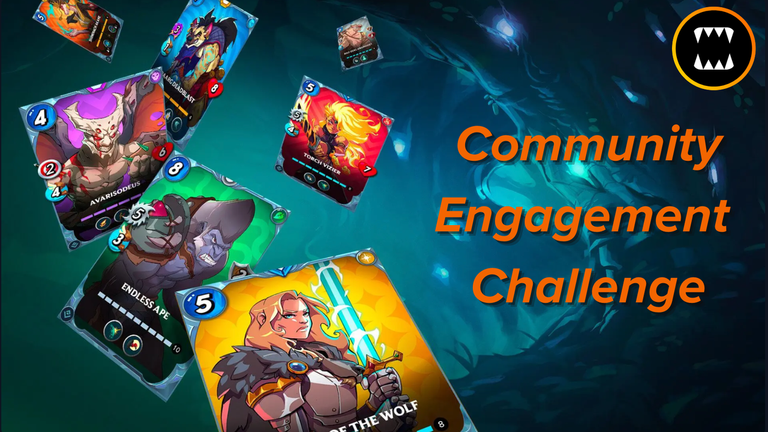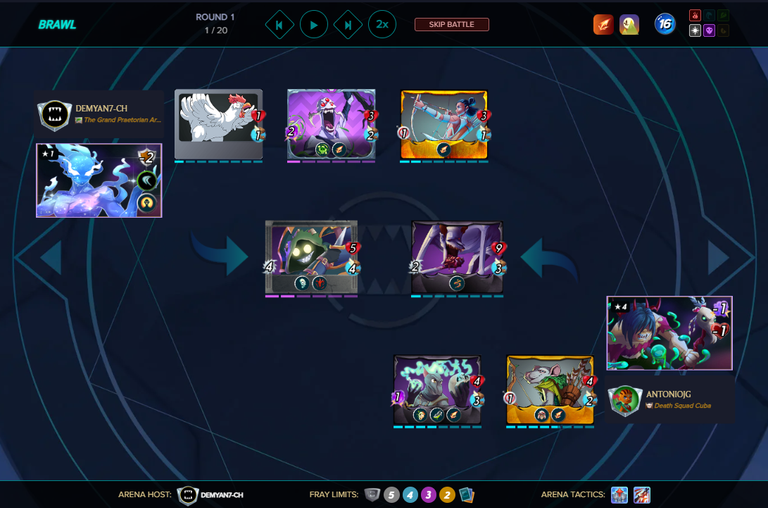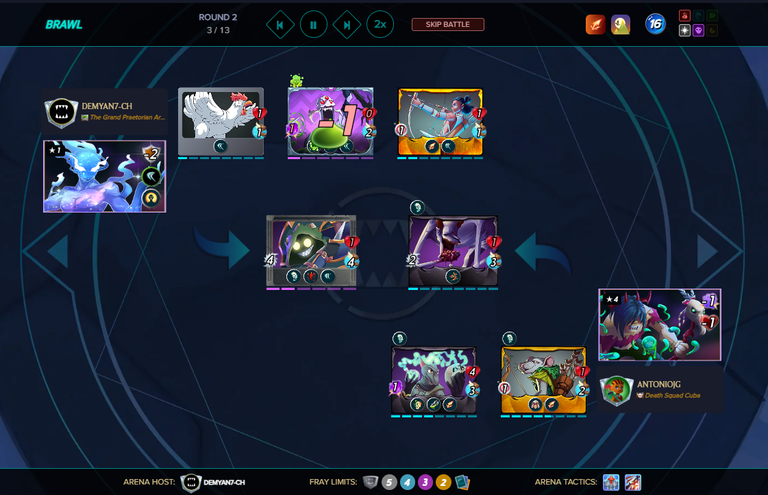Cursed Windeku y Venari Bonesmith dominaron una batalla de bajo maná y con la regla Lost Legendaries [Es/En]

Español
¡Saludos comunidad! En el reto de esta semana quiero compartir con ustedes un análisis de mi experiencia utilizando una estrategia con el Splinter de Muerte. La cual considero una excelente opción para aquellas partidas con un límite de maná bajo y con las reglas “Aimless” y “Lost Legendaries”. Es importante recordar que el tipo de ofensiva a utilizar en nuestras estrategias también dependerá del resto de reglas presentes en la batalla.
En esta oportunidad, les mostraré cómo afronté una batalla de Brawl de la liga de Plata en el formato Salvaje, enfocando mi análisis en explicar cómo combiné al Splinter de Muerte, el anchor Thaddius Brood y a las unidades Cursed Windeku, Venari Marksrat y Venari Bonesmith para ser coherente con las reglas de batalla presentes y las habilidades que quería combinar con la finalidad de tomar ventaja en la partida con la estrategia planteada.
Ya que estos aspectos son un factor clave con un impacto considerable en el desempeño de nuestras estrategias.

Conjunto de reglas y elección

Hablemos sobre el conjunto de reglas presentes en la batalla, este es el punto de partida para iniciar el análisis que nos llevará a la elección más adecuada para afrontar la batalla.
Límite de maná igual a 16 puntos, esta cantidad nos permite elegir anchors con un costo de maná entre 4 y 7 puntos. Sin embargo, es importante tener una estrategia bien definida para elegir a las unidades adecuadas con los puntos de maná restantes.
Aimless, es un regla que otorga la habilidad “Scattershot” a todas las unidades. Por otra parte, Lost Legendaries, no permite utilizar unidades Legendarias en la batalla.
Entonces, tomando en cuenta todos estos aspectos, decidí utilizar al Splinter de Muerte, ya que cuenta con unidades que poseen buenas estadísticas, entre ellas, un buen ataque melee y mágico. También cuenta con habilidades como: “Thorns”, “Martyr”, “Life Leech”, “Poison”, entre otras y con un anchor que reduce en 1 punto el ataque mágico y la vida del equipo enemigo.

Equipo y estrategia

Hablemos sobre el equipo y la estrategia que conforma. Dadas las circunstancias, era evidente el uso de cualquier tipo de ataque. Es por ello que decidí utilizar al anchor Thaddius Brood, ya que reduce en 1 punto el ataque mágico y la vida del equipo enemigo.
Cursed Windeku fue el tanque en esta oportunidad, ya que cuenta con buenas estadísticas, entre ellas, sus puntos de vida y ataque melee. También posee la habilidad “Thorns”, la cual le permite hacer un ataque melee adicional cuando es atacado por una unidad con ataque melee.
Venari Marksrat tiene el objetivo de incrementar las estadísticas de las unidades adyacentes a través de la habilidad “Martyr”. También contribuye con su ataque ranged.
Por último, Venari Bonesmith se ocupa de otorgar una ventaja considerable al equipo a través de la habilidad “Poison”. La cual se convierte en un arma letal en combinación con “Scattershot”, ya que eventualmente puede aplicar la habilidad a todas las unidades enemigas. Además, por cada ataque realizado incrementa sus puntos de vida mediante la habilidad “Life Leech”.

Estrategia en acción

Como les mencioné anteriormente, elegir al anchor Thaddius Brood y a las unidades Cursed Windeku, Venari Marksrat y Venari Bonesmith, fue una buena opción. Sin embargo, también es importante incluir habilidades de soporte que le permitan a nuestro tanque y al resto del equipo, resistir lo suficiente.
Observen como para el turno 3 de la ronda 2, el equipo enemigo estaba casi abatido. Cursed Windeku resistió bastante bien en la primera posición. Por otra parte, Venari Bonesmith actuó muy bien, debilitando al equipo enemigo. De igual manera lo hizo Venari Marksrat.
Si quieres ver la batalla completa, acá te dejo el enlace: CLIC PARA VER LA BATALLA

Conclusión
La estrategia planteada hizo un uso eficiente de la cantidad de maná disponible, cubriendo aspectos tales como: resistencia contra el daño enemigo, soporte del equipo, una buena ofensiva, y coherencia con el conjunto de reglas presente.
Una debilidad de esta estrategia es un equipo enemigo que cuente con resistencia a los ataques mágicos y físicos, e incluya habilidades como: “Void”, “Phase”, “Tank Heal”, “Heal”, “Triage”, “Silence”, “Magic Reflect”, “Amplify”, “Shield”, “Protect”, “Repair”, “Headwinds”, “Demoralize”, entre otras.
La diferencia entre las estrategias fue que el equipo enemigo no contaba con la resistencia suficiente para soportar los ataques de mi ofensiva.
Para el funcionamiento adecuado de nuestras estrategias, es importante considerar todos los aspectos involucrados, por lo que no sólo debemos enfocarnos en las estadísticas y habilidades a combinar. También debemos tener en cuenta la influencia de los conjuntos de reglas sobre la estrategia.
Este ha sido mi aporte al desafío semanal, ¡Espero haya sido de su agrado! ¡Saludos y hasta la próxima semana!

English
Greetings, community! In this week's challenge, I want to share with you an analysis of my experience using a strategy with the Dragon and Death Splinters. I consider this an excellent option for games with a low mana limit and with the “Explosive Weaponry” and “Taking Sides” rules. It is important to remember that the type of offense to use in our strategies will also depend on the other rules present in the battle.
This time, I will show you how I approached a Silver league Brawl battle in the Wild format, focusing my analysis on explaining how I combined Dragon and Death Splinters, the anchor Helios Matriarch, and the units Djinn Chwala, Naga Assassin, Kra'ar Xoc, and Silent Sha-vi to be consistent with the battle rules and the abilities I wanted to combine in order to gain an advantage in the game with the proposed strategy.
These aspects are a key factor with a considerable impact on the performance of our strategies.

Rulesets and choise

Let's talk about the set of rules present in battle. This is the starting point for the analysis that will lead us to the most appropriate choice for facing battle.
The mana limit is 16 points, which allows us to choose anchors with a mana cost between 4 and 7 points. However, it is important to have a well-defined strategy for choosing the right units with the remaining mana points.
Aimless is a rule that grants the “Scattershot” ability to all units. On the other hand, Lost Legendaries does not allow Legendary units to be used in battle.
So, taking all these aspects into account, I decided to use Death Splinter, as it has units with good stats, including good melee and magic attack. It also has abilities such as “Thorns,” “Martyr,” “Life Leech,” “Poison,” among others, and an anchor that reduces the enemy team's magic attack and health by 1 point.

Team and strategy

Let's talk about the team and the strategy it forms. Given the circumstances, it was clear that any type of attack would be used. That's why I decided to use anchor Thaddius Brood, as he reduces the enemy team's magic attack and health by 1 point.
Cursed Windeku was the tank this time, as he has good stats, including his health and melee attack. He also has the “Thorns” ability, which allows him to make an additional melee attack when attacked by a unit with a melee attack.
Venari Marksrat aims to increase the stats of adjacent units through the “Martyr” ability. He also contributes with his ranged attack.
Finally, Venari Bonesmith gives the team a considerable advantage through the “Poison” ability. This becomes a lethal weapon in combination with “Scattershot,” as it can eventually apply the ability to all enemy units. In addition, for each attack made, he increases his health points through the “Life Leech” ability.

Strategy in action

As I mentioned earlier, choosing anchor Thaddius Brood and units Cursed Windeku, Venari Marksrat, and Venari Bonesmith was a good choice. However, it is also important to include support abilities that allow our tank and the rest of the team to withstand enough damage.
Notice how by turn 3 of round 2, the enemy team was almost defeated. Cursed Windeku held up quite well in the first position. On the other hand, Venari Bonesmith performed very well, weakening the enemy team. Venari Marksrat did the same.
If you want to see the complete battle, here you have the link: CLICK TO WATCH THE BATTLE

Conclusion
The proposed strategy made efficient use of the available mana, covering aspects such as: resistance to enemy damage, team support, a good offense, and consistency with the current set of rules.
A weakness of this strategy is an enemy team that has resistance to magical and physical attacks and includes abilities such as: “Void,” “Phase,” “Tank Heal,” “Heal,” “Triage,” “Silence,” “Magic Reflect,” “Amplify,” “Shield,” “Protect,” “Repair,” “Headwinds,” “Demoralize,” among others.
The difference between the strategies was that the enemy team did not have enough resistance to withstand my offensive attacks.
For our strategies to work properly, it is important to consider all aspects involved, so we must not only focus on the statistics and skills to combine. We must also take into account the influence of rule sets on strategy.
This has been my contribution to the weekly challenge. I hope you enjoyed it! Greetings and see you next week!

Te invito a seguirme en / I invite you to follow me on: Twitter
Las traducciones fueron realizadas con el traductor / Translations were done with the translator: DeepL
Todas las imágenes fueron tomadas de / and all images were taken from: Splinterlands

https://x.com/AntonioJGB92/status/1954720386828083441
Thanks for sharing! - @lenonmc21

¡Gracias! | Thanks! ✌️
Congratulations @antoniojg! You received a personal badge!
You can view your badges on your board and compare yourself to others in the Ranking